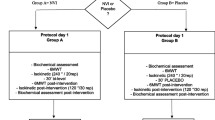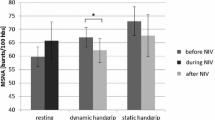Abstract
Increased ventilatory response to the metabolic demand (“ventilatory inefficiency”) is commonly found during dynamic exercise in patients with chronic obstructive pulmonary disease (COPD). However, the role of enhanced muscle ergoreflex activity on this phenomenon is yet unknown. Ten non-hypoxaemic patients with varying degrees of disease severity (median and range of post-bronchodilator FEV1 = 37.5 (27 to 70%) predicted) and 7 age- and gender-matched controls were studied. Subjects were submitted to wrist flexion tests to the limit of tolerance (Tlim) with and without post-exercise regional circulatory occlusion (PE-RCO) for 3 min. The muscle ergoreflex activity was quantified as the difference in ventilation between PE-RCO and control recovery periods corrected for the resting values (ergoreflex Δ). In addition, the area under the ventilatory curve in the recovery period was calculated in both conditions. We found that Tlim and the physiological stress associated with localized exercise did not differ between patients and controls. However, patients had increased ventilatory response to a given metabolic demand \(({\dot{\rm V}}\hbox{CO}_2),\) either at rest or during exercise (P < 0.05). There were no significant differences in ergoreflex Δ in patients and controls (−2.2 to 2.4 (0.2) vs. −0.6 to 1.8 (0.3) l/min, respectively). In addition, the area under the ventilatory curve in the recovery period did not differ between control and PE-RCO tests in patients and healthy subjects (P > 0.05). We conclude that increased muscle ergoreflex activity did not contribute to an excessive ventilatory response to exercise in patients with COPD—at least in non-hypoxaemic and non-cachetic subjects.

Similar content being viewed by others
References
Aliverti A, Macklem P (2001) How and why exercise is impaired in COPD. Respiration 68:229–239
Aliverti A, Dellaca RL, Lotti P, Bertini S, Duranti R, Scano G, Heyman J, Lo Mauro A, Pedotti A, Macklem PT (2005) Influence of expiratory flow-limitation during exercise on systemic oxygen delivery in humans. Eur J Appl Physiol 95:229–242
Allaire J, Maltais F, Doyon JF, Noel M, LeBlanc P, Carrier G, Simard C, Jobin J (2004) Peripheral muscle endurance and the oxidative profile of the quadriceps in patients with COPD. Thorax 59:673–678
Andreas S, Anker SD, Scanlon PD, Somers VK (2005) Neurohumoral activation as a link to systemic manifestations of chronic lung disease. Chest 128:3618–3624
Beaver WL, Wasserman K, and Whipp BJ (1986) A new method for detecting the anaerobic threshold by gas exchange. J Appl Physiol 60:2020–2027
Borg GA (1982) Psychophysical bases of perceived exertion. Med Sci Sports Exerc 14:377–81
Castagna O, Boussuges A, Vallier JM, Prefaut C, Brisswalter J (2007) Is impairment similar between arm and leg cranking exercise in COPD patients? Respir Med 101:547–553
Clark AL (2006) Origin of symptoms in chronic heart failure. Heart 92:12–16
Clark AL, Poole-Wilson PA, Coats AJS (1992) The relationship between ventilation and carbon dioxide production in patients with chronic heart failure. J Am Col Cardiol 20:1326–1332
Corra U, Mezzani A, Bosimini E, Scapellato F, Imparato A, Giannuzzi P (2002) Ventilatory response to exercise improves risk stratification in patients with chronic heart failure and intermediate functional capacity. Am Heart J 143:418–426
Drexler H, Riede U, Munzel T, Konig H, Funke E, Just H (1992) Alterations of skeletal muscle in chronic heart failure. Circulation 85:1751–1759
Floras JS (1993) Clinical aspects of sympathetic activation and parasympathetic withdrawal in heart failure. J Am Coll Cardiol 4:72A–84A
Francis DP, Shamim W, Davies LC, Piepoli MF, Ponikowski P, Anker SD, Coats AJ (2000) Cardiopulmonary exercise testing for prognosis in chronic heart failure: continuous and independent prognostic value from VE/VCO2 slope and peak VO2. Eur Heart J 21:154–161
Global Initiative for Chronic Obstructive Lung Disease (2001) Global Strategy for the Diagnosis, Management and Prevention of Chronic Obstructive Pulmonary Disease. NHLBI/WHO workshop report . Bethesda, National Heart, Lung and Blood Institute. Update of the Management Sections, GOLD website (http://www.goldcopd.com). Date updated 1 July 2003
Gosker HR, Wouters EF, van der Vusse GJ, Schols AM (2000) Skeletal muscle dysfunction in chronic obstructive pulmonary disease and chronic heart failure: underlying mechanisms and therapy perspectives. Am J Clin Nutr 71:1033–1047
Gosker HR, Lencer NH, Franssen FM, van der Vusse GJ, Wouters EF, Schols AM (2003) Striking similarities in systemic factors contributing to decreased exercise capacity in patients with severe chronic heart failure or COPD. Chest 123:1416–1424
Heindl S, Lehnert M, Peter-Criée C, Hasenfuss G, Andreas S (2001) Marked sympathetic activation in patients with chronic respiratory failure. Am J Respir Crit Care Med 164:597–601
Jakobsson P, Jorfeldt L, Brundin A (1990) Skeletal muscle metabolites and fibre types in patients with advanced chronic obstructive pulmonary disease (COPD), with and without chronic respiratory failure. Eur Respir J 3:192–196
Jones NL, Jones G, Edwards RH (1971) Exercise tolerance in chronic airway obstruction. Am Rev Respir Dis 103:477–491
Levison H, Cherniack RM (1968) Ventilatory cost of exercise in chronic obstructive pulmonary disease. J Appl Physiol 25:21–27
Lipkin DP, Jones DA, Round JM, Poole-Wilson PA (1988) Abnormalities of skeletal muscle in patients with chronic heart failure. Int J Cardiol 18:187–195
Macklem PT (2006) Circulatory effects of expiratory flow-limited exercise, dynamic hyperinflation and expiratory muscle pressure. Eur Respir Rev 15:80–84
McCloskey DI, Mitchell JH (1972) Reflex cardiovascular and respiratory responses originating in exercising muscle. J Physiol 224:173–186
Neder JA, Andreoni S, Castelo-Filho A, Nery LE (1999a) Reference values for lung function tests. I. Static volumes. Braz J Med Biol Res 32:703–717
Neder JA, Andreoni S, Peres C, Nery LE (1999b) Reference values for lung function tests. III. Carbon monoxide diffusing capacity (transfer factor). Braz J Med Biol Res 32:729–737
Neder JA, Nery LE, Castelo A, Andreoni S, Lerario MC, Sachs A, Silva AC, Whipp BJ (1999c) Prediction of metabolic and cardiopulmonary responses to maximum cycle ergometry: a randomized study. Eur Resp J 14:1304–1313
Neder JA, Nery LE, Peres C, Whipp BJ (2001) Reference values for dynamic responses to incremental cycle ergometry in males and females aged 20 to 80. Am J Respir Crit Care Med 164:1481–1486
Oelberg DA, Kacmarek RM, Pappagianopoulos PP, Ginns LC, Systrom DM (1998) Ventilatory and cardiovascular responses to inspired He-O2 during exercise in chronic obstructive pulmonary disease. Am J Respir Crit Care Med 158:1876–1882
Pereira CAC, Barreto SP, Simões JG, Nakatani J (1992) Valores de referência para espirometria em uma amostra da população brasileira. J Pneumol 18:10–12
Piepoli M, Clark AL, Volterrani M, Adamopoulos S, Sleight P, Coats AJ (1996) Contribution of muscle afferents to the hemodynamic, autonomic, and ventilatory responses to exercise in patients with chronic heart failure: effects of physical training. Circulation 93:940–952
Piepoli M, Ponikowski P, Clark AL, Banasiak W, Capucci A, Coats AJ (1999) A neural link to explain the “muscle hypothesis” of exercise intolerance in chronic heart failure. Am Heart J 137:1050–1056
Ponikowski P, Piepoli M, Chua TP, Banasiak W, Francis D, Anker SD, Coats AJ (1999) The impact of cachexia on cardiorespiratory reflex control in chronic heart failure. Eur Heart J. 20:1667–1675
Reinhard V, Muller PH, Schmulling RM (1979) Determination of anaerobic threshold by the ventilation equivalent in normal individuals. Respiration 38:36–42
Richardson RS, Sheldon J, Poole DC, Hopkins SR, Ries AL, Wagner PD (1999) Evidence of skeletal muscle metabolic reserve during whole body exercise in patients with chronic obstructive pulmonary disease. Am J Respir Crit Care Med 159:881–885
Rotto DM, Kaufman MP (1988) Effect of metabolic products of muscular contraction on discharge of group III and IV afferents. J Appl Physiol 64:2306–2313
Scano G, Grazzini M, Stendardi L, Gigliotti F (2006) Respiratory muscle energetics during exercise in healthy subjects and patients with COPD. Respir Med 100:1896–906
Scott AC, Francis DP, Davies LC, Ponikowski P, Coats AJ, Piepoli MF (2000) Contribution of skeletal muscle ‘ergoreceptors’ in the human leg to respiratory control in chronic heart failure. J Physiol 529:863–870
Scott AC, Wensel R, Davos CH, Kemp M, Kaczmarek A, Hooper J, Coats AJ, Piepoli MF (2002) Chemical mediators of the muscle ergoreflex in chronic heart failure: a putative role for prostaglandins in reflex ventilatory control. Circulation 106:214–220
Scott AC, Wensel R, Davos CH, Georgiadou P, Kemp M, Hooper J, Coats AJ, Piepoli MF (2003) Skeletal muscle reflex in heart failure patients: role of hydrogen. Circulation 107:300–306
Simon M, LeBlanc P, Jobin J, Desmeules M, Sullivan MJ, Maltais F. (2001) Limitation of lower limb VO2 during cycling exercise in COPD patients. J Appl Physiol 90:1013–1019
Stark-Leyva KN, Beck KC, Johnson BD (2004) Influence of expiratory loading and hyperinflation on cardiac output during exercise. J Appl Physiol 96:1920–1927
Whittom F, Jobin J, Simard PM, Leblanc P, Simard C, Bernard S, Belleau R, Maltais F (1998) Histochemical and morphological characteristics of the vastus lateralis muscle in patients with chronic obstructive pulmonary disease. Med Sci Sports Exerc 30:1467–1474
Author information
Authors and Affiliations
Corresponding author
Additional information
FPN is a recipient of a Scholarship Grant from CAPES.
JAN is an investigator (level II) of the Conselho Nacional de Desenvolvimento Cientí fico e Tecnológico (CNPq), Brazil.
Rights and permissions
About this article
Cite this article
Nakamoto, F.P., Neder, J.A., Maia, J. et al. Skeletal muscle ergoreflex overactivity is not related to exercise ventilatory inefficiency in non-hypoxaemic patients with COPD. Eur J Appl Physiol 101, 705–712 (2007). https://doi.org/10.1007/s00421-007-0543-3
Accepted:
Published:
Issue Date:
DOI: https://doi.org/10.1007/s00421-007-0543-3




